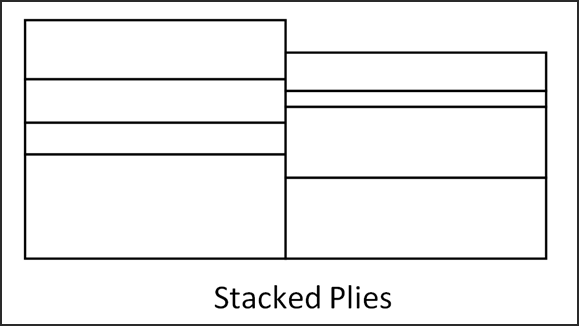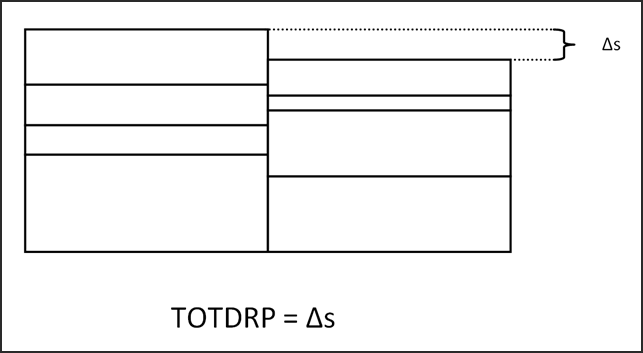DCOMP |

|

|

|

|
|
DCOMP |

|

|

|

|
DCOMP – Manufacturing Constraints for Composite Sizing Optimization
Defines manufacturing constraints for composite sizing optimization.
(1) |
(2) |
(3) |
(4) |
(5) |
(6) |
(7) |
(8) |
(9) |
(10) |
DCOMP |
ID |
ETYPE |
EID1 |
EID2 |
EID3 |
EID4 |
EID5 |
EID6 |
|
+ |
|
EID7 |
… |
|
|
|
|
|
|
+ |
LAMTHK |
LTMIN |
LTMAX |
LTSET |
LTEXC |
|
|
|
|
+ |
PLYTHK |
PTGRP |
PTMIN |
PTMAX |
PTOPT |
PTSET |
PTEXC |
|
|
+ |
PLYPCT |
PPGRP |
PPMIN |
PPMAX |
PPOPT |
PPSET |
PPEXC |
|
|
+ |
BALANCE |
BGRP1 |
BGRP2 |
|
BOPT |
|
|
|
|
+ |
CONST |
CGRP |
CTHICK |
|
COPT |
|
|
|
|
+ |
PLYDRP |
PDGRIP |
PDTYP |
PDMAX |
PDOPT |
PDSET |
PDEXC |
|
|
Field |
Contents |
|---|---|
ID |
Unique identification number. No default (Integer > 0) |
ETYPE |
Entity type for which this DCOMP card is defined. No default (PCOMP or STACK) |
EID# |
Entity identification numbers. List of entities of type ETYPE for which this DCOMP card is defined. No default (Integer > 0) |
LAMTHK |
Indicates that laminate thickness constraints are applied. Multiple LAMTHK constraints are allowed. |
LTMIN |
Minimum laminate thickness for the LAMTHK constraint. Default = blank (Real > 0.0) |
LTMAX |
Maximum laminate thickness for the LAMTHK constraint. Default = blank (Real > 0.0 and > LTMIN) |
LTSET |
Set ID of elements to which the LAMTHK constraint is applied. |
LTEXC |
Exclusion flag indicates that certain plies are excluded from the LAMTHK constraint. The following options are supported: NONE: Plies are not excluded. |
PLYTHK |
Indicates that ply thickness constraints are applied. Multiple PLYTHK constraints are allowed. |
PTGRP |
Ply orientation in degrees, ply sets or ply IDs, to which the PLYTHK constraint is applied, depending on the PTOPT selection. No default (Real or Integer) |
PTMIN |
Minimum thickness for the PLYTHK constraint. Default = blank (Real > 0.0) |
PTMAX |
Maximum thickness for the PLYTHK constraint. Default = blank (Real > 0.0 and > PTMIN) |
PTOPT |
Ply selection options for the PLYTHK constraint. Plies can be selected based on the following: BYANG: Orientation (Default) |
PTSET |
Set ID of elements to which the PLYTHK constraint is applied. |
PTEXC |
Exclusion flag indicates that certain plies are excluded from the PLYTHK constraint. The following options are supported: NONE: Plies are not excluded. |
PLYPCT |
Indicates that ply thickness percentage constraints are applied. Multiple PLYPCT constraints are allowed. |
PPGRP |
Ply orientation in degrees, ply sets or ply IDs, to which the PLYPCT constraint is applied, depending on the PPOPT selection. No default (Real or Integer) |
PPMIN |
Minimum percentage thickness for the PLYPCT constraint. Default = blank (Real > 0.0 and < 1.0) |
PPMAX |
Maximum percentage thickness for the PLYPCT constraint. Default = blank (Real > 0.0, < 1.0 and > PPMIN) |
PPOPT |
Ply selection options for the PLYPCT constraint. Plies can be selected based on the following: BYANG: Orientation (Default) |
PPSET |
Set ID of elements to which the PLYPCT constraint is applied. |
PPEXC |
Exclusion flag indicates that certain plies are excluded from the PLYPCT constraint. The following options are supported: NONE: Plies are not excluded. |
BALANCE |
Indicates that a balancing constraint is applied. Multiple BALANCE constraints are allowed. |
BGRP1 |
First ply orientation in degrees, ply sets or ply IDs, to which the BALANCE constraint is applied, depending on the BOPT selection. No default (Real or Integer) |
BGRP2 |
Second ply orientation in degrees, ply sets or ply IDs, to which the BALANCE constraint is applied, depending on the BOPT selection. No default (Real or Integer) |
BOPT |
Ply selection options for the BALANCE constraint. Plies can be selected based on the following: BYANG: Orientation (Default) |
CONST |
Indicates that a constant thickness constraint is applied. Multiple CONST constraints are allowed. |
CGRP |
Ply orientation in degrees, ply sets or ply IDs, to which the CONST constraint is applied, depending on the COPT selection. No default (Real or Integer) |
CTHICK |
Constant ply thickness for the CONST constraint. No default (Real > 0.0) |
COPT |
Ply selection options for the CONST constraint. Plies can be selected based on the following: BYANG: Orientation (Default) |
PLYDRP |
Indicates that ply drop-off constraints are applied. Multiple PLYDRP constraints are allowed. |
PDGRIP |
Ply orientation in degrees, ply sets or ply IDs, to which the PLYDRP constraint is applied, depending on the PDOPT selection. No default (Real or Integer) |
PDTYP |
Specifies the type of the drop-off constraint as: TOTDRP (Comment 5). |
PDMAX |
Maximum allowed drop-off for the PLYDRP constraint. No default (Real > 0) |
PDOPT |
Ply selection options for the PLYDRP constraint. Plies can be selected based on the following: BYANG: Orientation (Default) |
PDSET |
Set IDs of elements to which the PLYDRP constraint is applied. |
PDEXC |
Exclusion flag indicates certain plies are excluded from the PLYDRP constraint. The following options are supported: NONE: Plies are not excluded. |
Comments
| 1. | The following manufacturing constraints are available for ply-based composite sizing optimization: |
| • | Lower and upper bounds on the total thickness of the laminate (LAMTHK) |
| • | Lower and upper bounds on the thickness of a given orientation (PLYTHK) |
| • | Lower and upper bounds on the thickness percentage of a given orientation (PLYPCT) |
| • | Manufacturable ply thickness (PLYMAN) |
| • | Linking between the thicknesses of two given orientations (BALANCE) |
| • | Constant (non-designable) thickness of a given orientation (CONST) |
| • | LAMTHK, PLYTHK and PLYPCT can be applied locally to sets of elements. There can be elements that do not belong to any set. |
| 2. | These constraints are automatically created after performing free-sizing optimization when the OUTPUT,FSTOSZ control card is activated. |
| 3. | For a more detailed description and an example, refer to Optimization of Composite Structures in the User’s Guide. |
| 4. | Older versions of the DCOMP card (OptiStruct version 11.0 and prior) are supported and handled appropriately. |
| 5. | The option for selecting the type of drop-off constraints for PDTYP is defined for a set of plies, as shown in the figure below: |
The option for PDTYP in DCOMP is: TOTDRP.

Assuming that the plies are stacked as shown above, the following definition is:

| 6. | This card is represented as an optimization designvariable in HyperMesh. |
See Also: